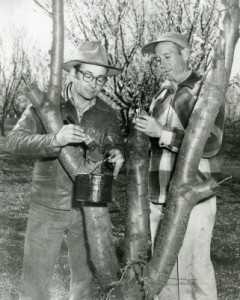Blue Diamond Is The Rarest Of Gems

It’s easy to forget just how far California’s almond industry has come, and just how instrumental Blue Diamond Growers has been. On May 6, 1910, 230 growers met at the Hotel Turclu in Sacramento to form Blue Diamond’s predecessor, the California Almond Growers Exchange. Seeking greater safety in numbers, the growers came from nine grower associations, representing 1,200 tons of almonds and 60% of the probable California crop.
Today, Blue Diamond has 3,300 growers out of 6,000 in the state. As a whole, the state’s growers may produce 1.65 billion pounds of almonds this year on 740,000 bearing acres. The small, vulnerable association has grown to become the world’s largest and most respected almond processor, and a marketing powerhouse.
Sure, Blue Diamond and the almond industry have come a long way, but you don’t have to look back 100 years. Try 10 years ago. It seems almost preposterous now, but it was just a decade ago that many of the state’s growers were in the dumps, depressed about their crop’s prospects. Doug Youngdahl, who recently stepped down as Blue Diamond’s president and CEO, had just taken the job when the millennium turned. Youngdahl recalled those dark days recently in his 2010 annual meeting address at Blue Diamond’s Centennial Celebration.
A Good Attitude
“Ten years ago when I began my tenure as your CEO, Blue Diamond grower members and its management team were facing serious challenges,” said Youngdahl. “At that time, the fear of larger and larger almond crops had caused prices to sink to levels below the cost of production.”
Youngdahl said the situation was incredibly frustrating because each crop was being readily consumed by global markets. But if growers couldn’t get fair prices, the industry wouldn’t be sustainable. Blue Diamond convened the first-ever annual strategic planning session in which the Board of Directors and key managers met for several days with “everything on the table.” They sought to redefine and simplify a rational marketing plan, which they unveiled at the International Tree Nut Congress in Spain in May 2001. There Youngdahl delivered the almond keynote address.
“The thesis of my presentation was that large crops do not automatically mean low prices,” he said, showing charts that illustrated demand was growing as fast as supply. “I also cautioned the audience that the presentation was not to be construed as a call to plant more almonds. Rather, it was a message to global markets that adequate almond supply in the future was in jeopardy unless grower returns rise to levels above the cost of production.”
Youngdahl, who studied economics, said there are more factors at work than supply and demand. “The level of confidence in the market is critical. In the almond industry we allowed those who were pessimistic to have greater influence than they warranted,” he said. “Attitudes are contagious, and Blue Diamond has a sunny disposition. We’re realistic optimists.”
Beautiful Bloom
Besides a general shift in attitude, Blue Diamond took several steps to increase efficiency and profitability. They eliminated 68% of their products, especially those with low sales that required lots of inputs. They also increased automation. For example, they had a re-grade room for almonds that had 12 sorting tables, each with 12 sorters. They introduced an electronic system that eliminated the need for all those sorting jobs. The end result was they cut hourly payroll by 50% and salaried staff by 35%, said Youngdahl.
Then in the spring of 2002, with a lot of nonbearing acreage just coming into production, there was a beautiful bloom. Word came out that California would have its first billion-pound crop, said Youngdahl. Those in the industry worried how the world markets were going to absorb the crop and the presumed fait accompli of lower prices. But Blue Diamond marketers argued that almonds were versatile, they were used by a multitude of industries, and they tasted great and were nutritious.
They said growers should get a sizable premium on products with almonds because global markets in the food industry will embrace them, said Youngdahl, adding that’s exactly what happened. The demand readily followed the supply. “What we were saying made good sense to the industry, and it certainly made good sense to California almond growers,” he said. “That conversation permeated the coffee shops around the state, and our team played a large part in how that got going.”
Big Plans In Store
Today, the confidence level in the industry is high. Mark Jansen, who recently took the reins from Youngdahl, inherits a much better situation. He comes from a marketing background, specifically a food marketing background, and is eager to get to work selling almonds. “The crop itself was a big factor,” he said. “With almonds, they are naturally healthy, so the ability to continue to increase consumption is wind in the sails for this company.”
Jansen has worked on marketing a number of top brands, including Häagen-Dazs, Betty Crocker, and Pillsbury. His goal is to make Blue Diamond — which was chosen 100 years ago as the symbol of the California Almond Growers Exchange because it was the rarest of gems — as well-known around the world. “Blue Diamond is a brand that has incredible potential,” he says. “It has every ability to be an international mega brand like others I have led.”
Jansen clearly has big plans, and believes that Blue Diamond’s longtime exposure to world markets — Blue Diamond salesmen were in Europe prior to World War I — is a huge advantage in taking that next step. “Increasingly what we’ll be focused on is leveraging those longtime international relationships and taking the volatility out of the market,” he says. “We want that sense of customer intimacy. There may be a handful of handlers who try to do that, but no one can do that like Blue Diamond.”









